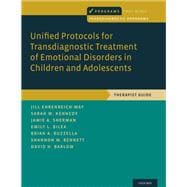The Unified Protocols for Transdiagnostic Treatment of Emotional Disorders in Children and Adolescents, based in groundbreaking research from Jill Ehrenreich-May, David H. Barlow, and colleagues, suggest that there may be a simpler and more efficient method of utilizing effective strategies, such as those commonly included in CBT and third-wave behavior therapies, in a manner that addresses the broad array of emotional disorder symptoms in children and adolescents. The Unified Protocols for children and adolescents include a Therapist Guide with two full courses of therapy described (a modular, individual therapy for adolescents; and, a more structured, group therapy for children, complete with a full parent-directed component), as well as two Workbooks, one for children along with their parents or caregivers, and one for adolescents.
The child and adolescent Unified Protocols frame effective strategies in the general language of strong or intense emotions and promote change through a common lens that applies across emotional disorders, including anxiety, depression, obsessive compulsive disorders and others. Specifically, the child and adolescent Unified Protocols help youth by allowing them to focus on a straightforward goal across emotional disorders: reducing intense negative emotion states by extinguishing the distress and anxiety these emotions produce through emotion-focused education, awareness techniques, cognitive strategies, problem-solving and an array of behavioral strategies, including a full-range of exposure and activation techniques.








